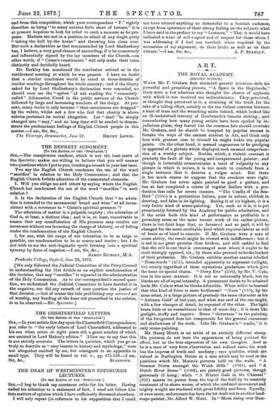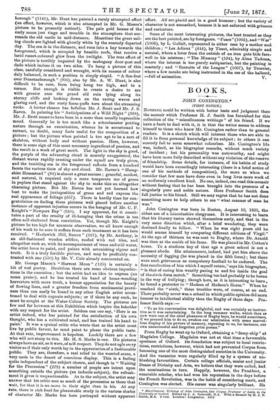ART.
[SECOND NOTICE]
WHEN Mr. P. Graham first attracted general attention with his powerful and promising picture, "A Spate in the Highlands," there were a few admirers who thought the chorus of applause with which it was received too indiscriminate. They perceived, or thought they perceived in it, a straining of the truth for the sake of a telling effect, notably in the too violent contrast between a knot of trees and the wreathing mists behind, which looked like an ill-understood travesty of Rembrandt's famous etching ; and remembering how many young artists have been spoiled by in- judicious praise, they feared lest the common fate should overtake Mr. Graham, and he should be tempted by popular success to forsake the ways of the earnest student in Art, and think only how with greatest ease to himself he might tickle the popular palate. On the other hand, it seemed ungenerous to be grudging in approval of a picture which displayed such unusual comprehen• sion of a worthy subject. Besides which, a violent contrast is precisely the fault of the young and inexperienced painter ; and though it invariably communicates a taint of vulgarity to any picture in which it occurs, it is too much to conclude from single instance that it denotes a vulgar mind. But there is too much reason to suppose that the croakers were right. Mr. Graham has never again painted so good a picture, and has at last completed a course of regular decline with a pro- duction that calls for severe censure. "The Cradle of the Sea- Bird" (1055) is a pretentious failure, poor in colour, childish in drawing, and false in its lighting. Rating it at its highest, it is a very feeble kind of scene-painting. Yet, such as it is, it is put prominently forward by the Academy for public admiration, and if the artist finds this kind of performance as profitable in a pecuniary sense as the more honest work of his earlier picture, there is but faint hope that, so favoured and so paid, it will be changed for the more creditable kind which requires labour as well of brain as of hand to execute. If Mr. Graham were a man of mean ability, the result might be viewed with indifference ; but it is sad to see great promise thus broken, and still sadder to find that the evil is one that is encouraged most where it ought to be most strongly opposed, viz., by those who pretend to be the leaders of their profession. Mr. Graham exhibits another canvas labelled " Homewards " (471), intended apparently to represent twilight, but utterly regardless of those mysterious gradations which give the hour its special charm. "Dewy Eve" (550), by Mr. V. Cole, sins in the same manner. It is not so universally black, but its blacks are all of equal intensity. A paramount desire to be admired leads Mr. Cole to what he thinks isforcible. When will it be learned that this kind of force is mere feebleness? "Noon "(110), by the same artist, is a large picture of precisely the same character as his "Autumn Gold" of last year, and what was said of the one might, with a few changes of detail, be repeated of the other. The light bears little or no resemblance to that of noon-day ; it is more like gaslight, stuffy and impure. Some " cleverness " in the painting of the foreground does not compensate for the general coarseness and shallowness of the work. Like Mr. Graham's "cradle," it is only scene-painting.
Mr. Henry Moore is au artist of an entirely different stamp. His pictures do not bear the appearance of being painted for
effect, but as the true expression of his own thoughts. And as he is a man of very keen observation and refined taste, his work has the impress of truth and modesty ; rare qualities, which are valued in Burlington House at a rate which may be read in the
positions which Mr. Moore's pictures hold on the walls. "A Summer Storm amongst the Welsh hills" (1049), and "A.
Dutch River Scene" (1066), are plainly good pictures, though grievously ill hung ; while "A Winter Gale in the Channel" (933) asserts its power from the top of the wall by its masterly
treatment of in-shore waves, of which the confused movement and mighty weight are rendered with great fidelity and force. Equally, or even more, unfortunate has been the lot dealt out to another land- scape-painter, Mr. Alfred W. Hunt. In "Moon rising over Barn-
Mr. George Mason's "Harvest Moon" (125) is certainly a bit of real poetry. Doubtless there are some obvious imperfec- tions in the execution ; but the artist had an idea to express (no mean praise), and he has treated his band of home-wending harvesters with more truth, a keener appreciation for the beauty of flowing lines, and a greater freedom from sentimental pretti- ness than can easily be found in any other English artist accus- tomed to deal with cognate subjects ; or if there be any such, he must be sought at the Water-Colour Society. The pictures are few and far between at this Exhibition which inspire the beholder with any respect for the artist. Seldom can one say, 'Here is an artist indeed, who has painted for the satisfaction of his own thought, who has a cultivated mind, and has trained his hand to paint.' It was a cynical critic who wrote that as the artist must live by public favour, he must paint to please the public taste. At that rate, improvement is hopeless. Luckily there are a few who will not stoop to this. Mr. H. S. Marks is one. His pictures always have an air, as it were, of self-respect. They do not ogle every visitor as if their only worth lay in the appreciation of a fashionable public. They are, therefore, a real relief to the wearied sense, a very oasis in the desert of conscious display. This is a feeling quite independent of the subject chosen, and though in "Waiting for the Procession" (279) a number of people are intent upon something outside the picture (an indocile subject), the refresh- ment it gives is unquestionable. As to the subject, the artist may answer that his critic sees as much of the procession as those that wait, for that it is no more in their sight than in his. At any rate, there is rich food for pleasurable study in the various shades of character Mr. Marks has here portrayed without apparent effort. All are placid and in a good humour ; but the variety of character is not unmarked, because it is not enforced with grimace and caricature.
Some of the most interesting pictures, the beat treated as they are the best painted, are by foreigners. "Peace" (1005), and "War" (1006), by L. Gallait, represented in either case by a mother and. children ; "Lea Adieux" (644), by Tissot, admirably simple and. natural, where a lover from the outside of an iron gate bids fare- well to his mistress ; "The Mummy" (524), by Alma Tadema, where the interest is too purely antiquarian, but the painting is masterly ; and "Recruits of the League" (1007), by Tourrier, where a few monks are being instructed in the use of the halberd,



































 Previous page
Previous page